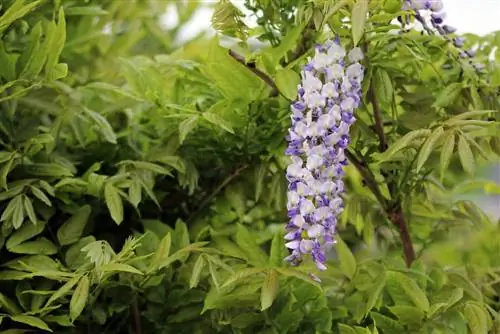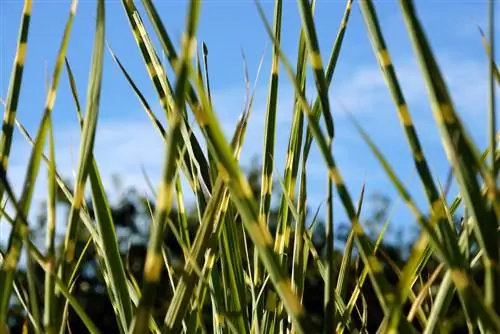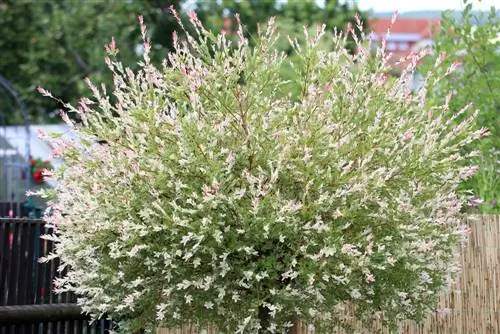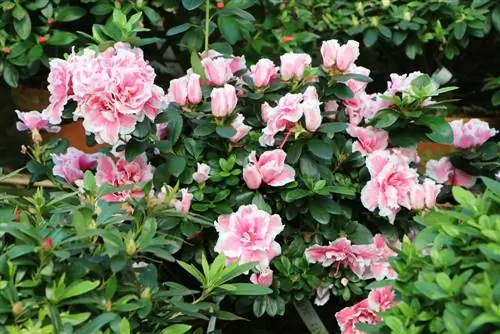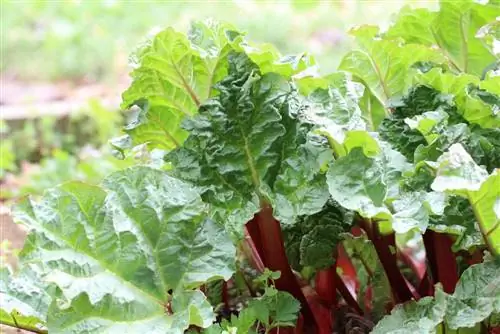- Author admin [email protected].
- Public 2023-12-17 03:39.
- Last modified 2025-01-24 12:45.
The wisteria has the botanical name Wisteria and belongs to the family of butterflies. The climbing bush grows strongly and can wind up to eight meters high. The leaves are pinnate and produce clusters of flowers in May, which are either blue, pink or white, depending on the variety. If wisteria grows in soil containing nitrogen, growth increases, but this often occurs at the expense of flower development. In order to ensure that the flowers are plentiful, at least two prunings per year are necessary.
Characteristics
In a sunny location in a sheltered location, the wisteria thanks you with a rich floral display. If the soil is very rich in nitrogen, this often leads to a strong vegetative growth spurt, which, however, has a negative effect on flower formation. In addition, the twining and woody shoots can quickly clog gutters and rain pipes, and in extreme cases can even compress them or completely bend railings. The following characteristics are important for wisteria:
- Frost-hardy but heat-loving climbing plant
- Growing creeper with enormous power
- Needs walls, extremely stable pergolas, massive rose arches or fences as support
- Hangs picturesquely with support in flower clusters
- Flowering time in May-June
- Can be grown on a wall as a trellis or standard tree
- In order to preserve the flowers in the long term, rigorous pruning is necessary
- Prune flower-bearing short shoots at least twice a year
- Ideally start pruning in late summer and at the end of winter
- Can even tolerate radical pruning, as thick branches will sprout again
Maintenance cut in summer
For plants that are already established, the aim of maintenance pruning is to limit the unwanted spread of wisteria and to sustainably promote the development of as many flowering short shoots as possible. The following aspects must be taken into account when pruning in summer:
- Maintenance pruning ensures even richer blooms
- Short all short shoots in two steps
- Plan the first cut in summer (approx. two months after flowering)
- Cut back all this year's side shoots to approx. 30-50?cm
- If new shoots arise from this, break them off before they become woody
- Summer pruning significantly slows growth
- Pruning stimulates the formation of new flower buds
Winter/spring cutting
After pruning in summer, the next cut is due at the end of winter. In wisteria, the flower buds are located directly at the base of the short shoots and can therefore be easily distinguished from the leaf buds, as these are now significantly larger and thicker. Over time, thickenings develop, the so-called 'heads', on which more flower buds form. The following procedure should be used for winter/spring pruning:
- Second pruning during the last days of winter in March
- Short the short shoots that were already cut back over the summer to 2-3 buds
- Also prune the two-year-old side shoots that are still green
- To encourage branching, shorten all flowerless shoots to a third
- As the abundance of flowers decreases, gradually cut off the oldest branches
- Cutting out the over-aged 'heads' stimulates the formation of new and flowering short shoots
Tip:
It is important to always cut above the fifth leaf bud so that the plant sap can flow completely into the flower buds of the current year.
Rejuvenation cut
The wisteria is one of the extremely long-lived climbing plants and can grow enormously tall and wide. Normally, with regular pruning, an additional rejuvenation cut is unnecessary. However, if the climbing plant has become much too large, then a significant rejuvenation cut should be carried out:
- Apply rejuvenation cuts gradually over several years
- Only cut out one of the supporting main shoots
- Incorporate a suitable support into the plant framework as a replacement
- In extreme cases, you can even cut back to a height of one meter
- In the following years, completely rebuild the plant crown
Tip:
Extreme pruning for rejuvenation is only recommended if the wisteria has been neglected and has not been pruned at all for several years.
Educational Cut
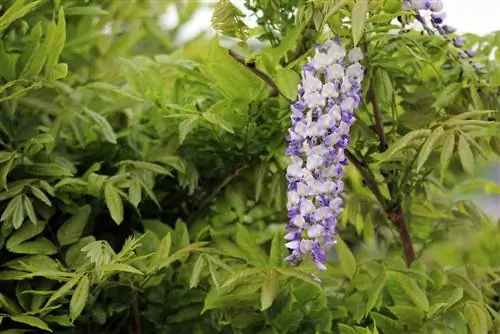
Young plants need training in order to grow in the desired shape and direction. The use of the training pruning mainly depends on whether the wisteria in question is to be pulled up as a trellis on the wall or on a pergola. If the plant is left to grow without training, the shoots become so entangled and intertwined that proper pruning is no longer possible after just a few years. Tying the wisteria down is important because this creates a sap that encourages the plant to form side shoots. The following cutting rules must be followed until the young wisteria has sufficient pairs of side branches so that the trellis can be completely filled:
- Build a framework from just a few shoots
- Basic structure remains for life, on which flower-bearing short shoots are formed
- Construction of the framework takes at least 3-4 years, regardless of the growth form selected
- For pergola or rose arch training, tie 2-3 of the strong main branches to the climbing aid
- Wind the shoots around the scaffold, then loosen and tie them at the same time
- Short the extension shoot to approx. 1 m annually in late summer or at the end of winter
- For wall espalier training, cut off the young plant to approx. 70-90?cm above the strong eye
- Remove all side shoots, attach the shortened leading shoot tightly to the post
- Only leave 2 side shoots in summer
- Direct the remaining side shoots up the trellis at a 45° angle
- Short the next side shoots to approx. 10-15?cm
- Cut off the leading shoot approx. 70-80?cm above the top branch at the end of winter of the 2nd year
- Short the side shoots again by a third and tie them down
- Short the leading shoot again in the summer of the following year
- Now guide the next pair of lateral branches diagonally upwards
- Again shorten all branches of the side branches to approx. 15 cm
- Remove unnecessary and unwanted shoots from the base and main shoot
Tip:
With refined wisteria, make sure that the underlying wood does not drift through. All shoots that arise at ground level must be consistently removed, as these are probably wild shoots.
Damage caused by vigor
The wisteria is an extremely powerful creeper that devours everything around it. Therefore, care must always be taken to ensure that the neighboring plants are not put in distress. Due to its enormous power, wisteria can even damage parts of the house and especially gutters. To prevent this from happening, the following aspects must be taken into account:
- Check plant growth regularly for excess growth
- Always place trellises at a distance of at least 1 m from building facades
- Do not let it grow over railing bars
- Be careful with nearby anchors
Conclusion
The wisteria is a fast and strong growing climbing plant that needs pruning at least twice a year. Otherwise, excessive growth will quickly occur and, in extreme cases, even damage to the surrounding area. Since wisteria is very easy to cut, pruning can be carried out without any problems and small cutting errors are quickly corrected. If the plant is not pruned, the flowers will only develop very weakly or not at all. It is also important to have a low nitrogen content in the soil, as this promotes vegetative growth but has a detrimental effect on the abundance of flowers. Ideally, the first pruning is done at the end of summer after flowering and the second pruning at the end of winter. If the plant has been neglected for a long time, a radical rejuvenation pruning should be carried out. In order to get a young wisteria into shape, appropriate training sessions are necessary in the first few years of life.

